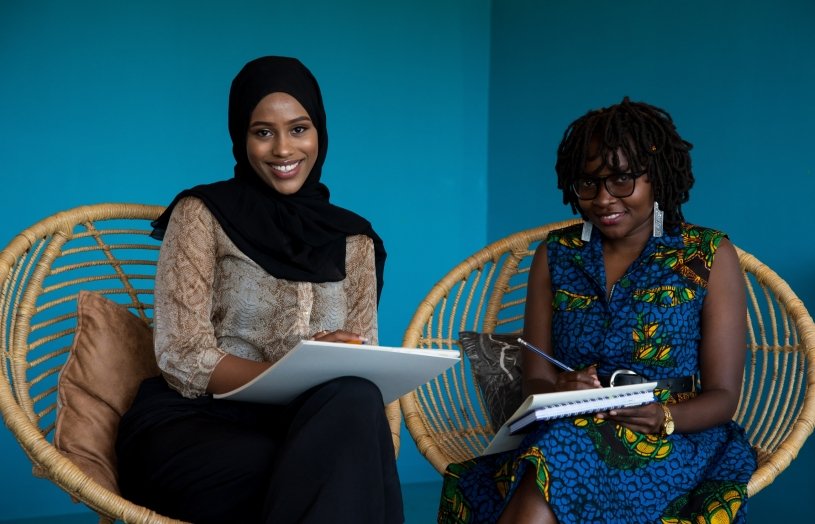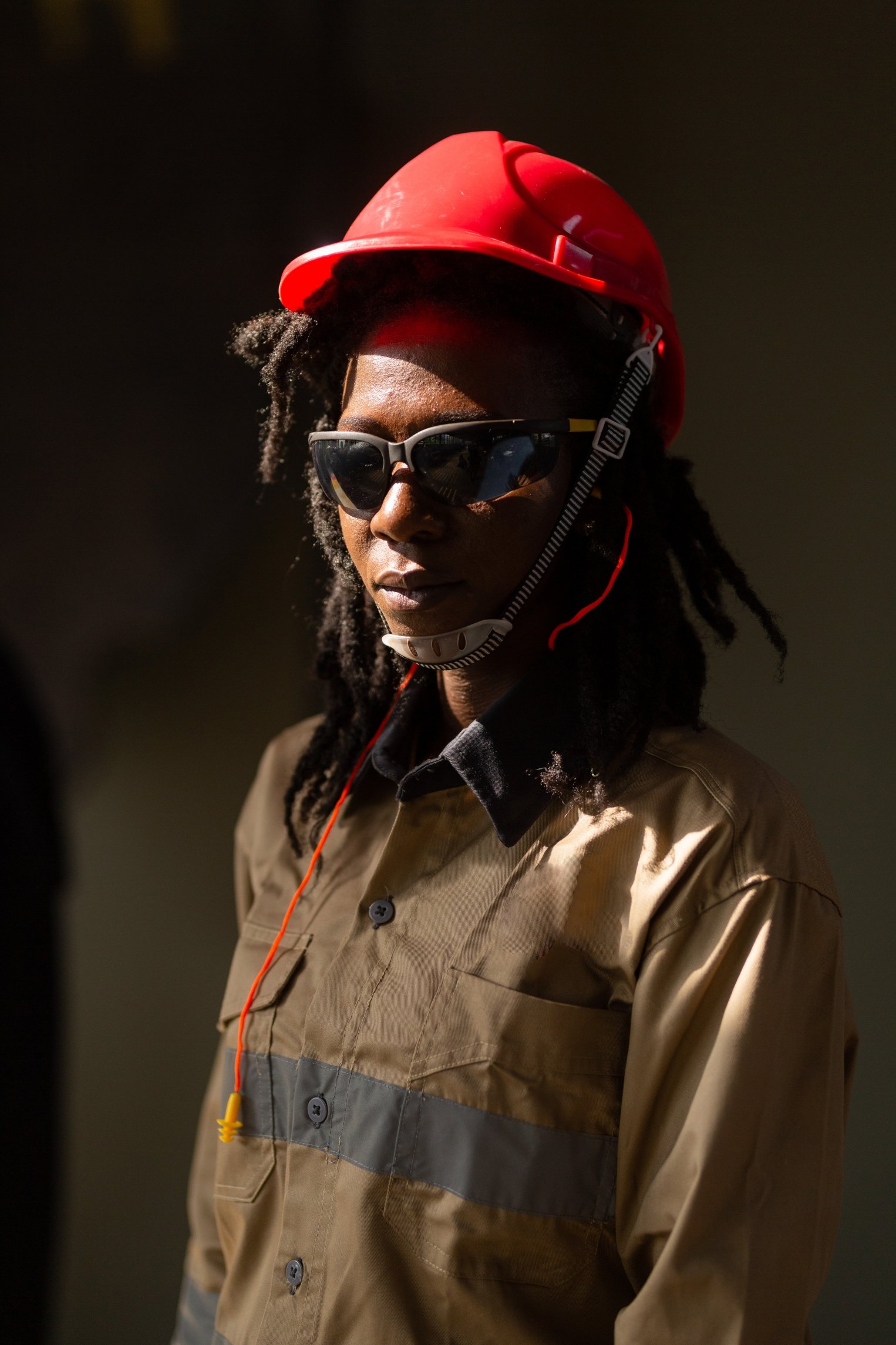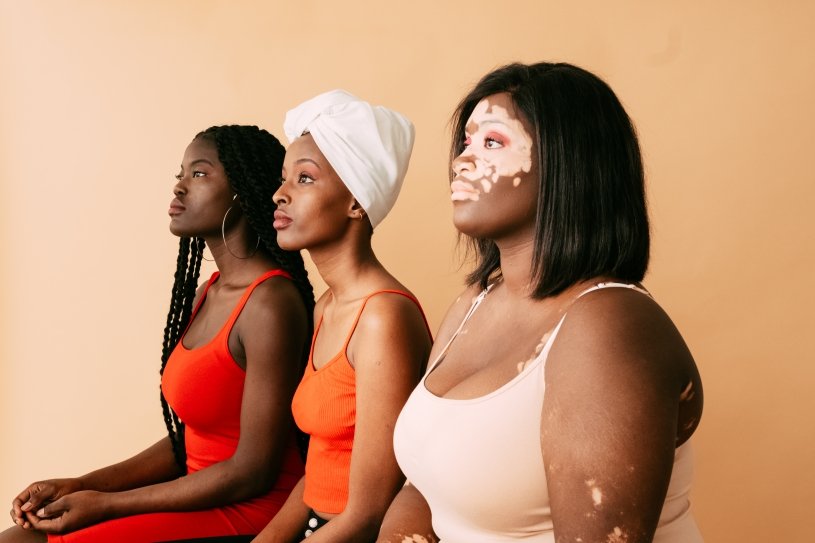Representing Women Today Through Images
Written by Caroline Desrosiers, founder & CEO of Scribely | Cover image by Christin Nzobadila-Bela for the Afrofemme Collection | Alt Text: A three quarter interior shot of 3 Black people sitting side by side staring with confidence off into the distance. 1 has long tight braids, another wears a head wrap, and the third has a cloudlike patch of vitiligo across their eyes. They are sitting against a peach colored backdrop. They all wear tanktops, 2 are bright red and orange and the other is off-white.
Our faces and voices represent us, helping us be seen and heard.
Through images on the web we gain awareness and understanding of women’s experiences around the world, helping us understand lives outside our own.
What does the modern woman look like? What does she represent? How is she changing?
Think of the images that businesses use to sell products to their customers, the images that news agencies present of women throughout the world, the images women choose to present of themselves and other women on social media.
With each new image posted to the web, we are creating a gallery of our time – shaping our perception of reality in the present, and creating a record of our time for the future.
How Can We Celebrate the Diversity of Women?
If we look closely at one image of one woman, we have a chance to understand what she may be experiencing or how she feels in the moment. As we look at more images of women from different backgrounds, we have an opportunity to understand a generation.
In the 2020s and beyond we need to see diverse representation go beyond simple demographics like race and gender. Truly representing diversity for women means considering a wide range of factors that make us unique – everything from age and sexual orientation to body size and disabilities.
The way women identify and express themselves is important to represent because it is part of who they are. We need to recognize and embrace different identities and create safe spaces where people feel like they don’t need to change who they are for the people around them. The PICHA Stock
Afrofemme collection is a great example of this because it is a celebration of the diversity of women. Scrolling through this gallery provides a gateway to discovering the collective experience of women today, to understanding their beauty, power, and influence.
Diverse images bring us closer to describing who the modern woman is, helping us create a web that actually looks like our reality.

Alt Text: 2 Black people sit in wicker chairs in a teal colored room holding notebooks and pads of paper and smiling up at the camera. 1 wears a black hijab, long sleeve and full length black skirt. The other wears a bright blue, green and yellow sleeveless tea length dress.
How Can We Fight Stereotypes That Set Women Back?
Stereotypes impact our self-concept and ability to perform. Psychologists have experimentally demonstrated what they call a “stereotype threat “ – a fear of doing something that would confirm negative perceptions of a stigmatized group we belong to (NIH).
How do we fight against the damaging impact of these stereotypes? We can start by understanding them and examining how they present a threat to women.
Here are the most common stereotypes we find in images of women …
- Objectification. Presenting women as props or objects is dangerous because it dehumanizes them and makes them appear inferior within society as a whole. Perpetuating power dynamics creates an alternate reality that does not reflect the equality that exists within the human experience.
- Sexualization. This stereotype can be damaging at times and liberating at others. What’s the difference and how do we avoid using the wrong imagery? A good place to start is to look closely at the power dynamics within the picture. Is the woman in control of presenting her sexuality?
- Identity. The identity of a woman is not biological. Women are not all feminine in the traditional sense. Androgynous women are not masculine. We can use images to break down barriers and blur the lines of identity. Identity is individualistic.
- Angry Women. While we as humans may have a natural emotional reaction to anger, there is nothing wrong with being angry. We need to retrain our eyes and ears to perceive angry women equally to angry men. Anger has the power to accelerate progressive action and societal change.
How Can Images Challenge the Status Quo?
Represent women in male-dominated professions.
Women are becoming part of every aspect of the workforce. While some cultures are further along than others, it’s clear that women are making progress here. The more images we see of women in male-dominated professions, the more we help women imagine themselves pursuing these career paths.
Shining a light on diversity at work helps us change our misconceptions that gender somehow determines our abilities or options in life. We need to represent women whenever we find they are in the minority so we can break down these barriers and build a more diverse workforce across industries.

Alt Text: A Black person with shoulder length dreadlocks wears a bright red hard hat with chin strap, dark glasses, and a tan long sleeve button up shirt with gray stripes. They have one ear plug in their right ear and the other dangling down in front of their chest. They are calm and confident.
Represent female photographers from around the world.
Photography continues to be a male dominated field. Women have different perspectives to offer and need to be a part of capturing what it means to live this moment in history. If we bring female photographers to the foreground we can diversify the images on the web even more.
Archives like PICHA Stock feature the work of female photographers, giving us access to diverse perspectives.
Why Is It Important to Describe Images on the Web?
The way we describe images of women, and all images for that matter, is just as important as the images themselves.
The words we choose to describe images impact our perception and interpretation of our world and help organize the vast visual catalog of digital images on the web.
People who are blind/low vision rely on image descriptions (alt text) on the web. According to an annual survey of one million homepages, 66% of websites are missing image descriptions (Web AIM). On top of that, the image descriptions that do exist are often inaccurate, incomplete, or misleading. This means most of the visual information on the web is not accessible to people who cannot see it.
It’s important to understand how to describe images so that we can represent them in the right way and break down web access barriers.
How Do We Describe the Images We Share?
- Begin from a place of empathy. We should start by taking the perspective of another person who cannot see this image. We need to imagine ourselves in the position of describing this image to a blind friend or a person who is not able to see the image at the moment.
- Think about the function of the image. The purpose of an alt text is to describe images to people and search engines who cannot see them. We can think of these descriptions as mini stories that tell us the most important details of an image. To keep women’s stories paramount in people’s minds, those stories need to be accessible on the internet.
- Reflect on the context of the image. Every image of women has a purpose or function on the page. Understanding the context of the image is absolutely essential as that is what ultimately determines the visual details we provide. The same image can have different meanings in different contexts. For example, a photo of a ballet dancer in a textbook about form and technique vs. that same image used for artistic purposes on a dance studio’s website.
- Focus on the subject of the image first. We should begin with the most important information. It is critical to think about the primary subject of the image and create a description that conveys the most important message related to it. If we can’t find a subject for the image, we need to start with the most general and high-level details and then drill down into the specifics.
- Provide all of the relevant visual details. Adding visual details, if there is space to do so, helps provide a complete description of the image. Ideally, we should describe the details that are most relevant to the subject or the purpose of the image.
- Keep it short. It’s important to be as succinct as possible. This helps people and search engines quickly and effectively navigate the web.
- Understand offensive language biases. Aside from gender, it’s important to pay attention to words that people find offensive. For instance, “people confined to a wheelchair” vs. “people using a wheelchair.” Or, “homeless” vs. “people experiencing homelessness.” When in doubt, we should use a person-first approach to shortcut labels.
Images Are Our Legacy
The images we choose to present to the world will represent the women of our time. The words we choose to describe them explain what these images mean to us. This International Women’s Day, let’s choose to represent women as they are right now and imagine together the future we want to see.

Alt Text: An interior medium shot of a Black person sitting with arms crossed on a high table staring at a chess board before a game is about to begin. Their hair is parted down the middle and pulled back into a low tight bun and they wear ear piercings in their left ear. Daylight spills into the room, illuminating her face and the chessboard.
About Today's Featured Guest Blogger
As PICHA is a proudly female-owned company, we're celebrating International Women's Day by partnering with another female founder who is just as dedicated to creating a more inclusive digital world - the talented Caroline Desrosiers. She is the Founder and CEO of Scribely, a San Francisco-based accessibility solutions company that focuses on writing premium photo descriptions (alt text) for websites, digital products and social media to help businesses create a more inclusive, equitable, and sustainable world.
